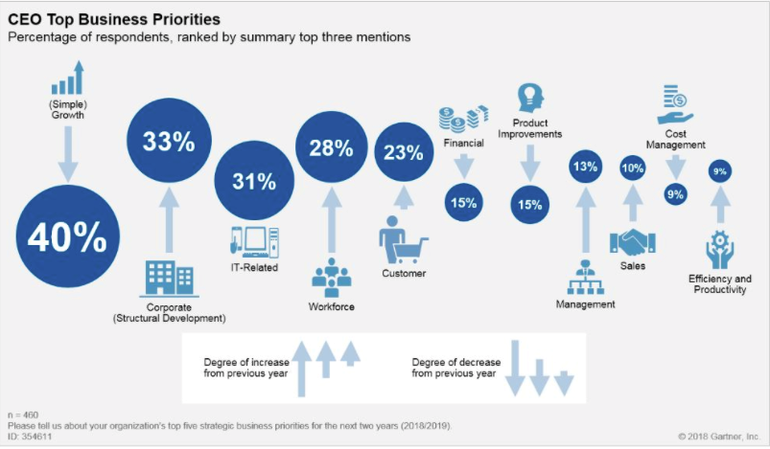1. What is digital transformation?
Digital transformation can be described as using digital technologies in all areas of a business, which ultimately results in fundamental changes in business operations, making them significantly better. The idea behind digital transformation is not only to recreate an existing service in a digital form but to make use of different technologies to make those services effective and efficient.
Digital transformation can be defined as an approach that closes the gap between digital customers’ expectations and what analog businesses are able to deliver. Digital transformation can include a list of recent technologies, however, the Internet of Things, Cloud Computing, Machine Learning, Big Data, and Artificial Intelligence are some of the most influential ones.
2. Is Digital Transformation more than just a buzzword?
According to IDC, worldwide spending on digital transformation technologies including hardware, software, and services has hit $1.3 trillion in 2017. Further, IDC expects these spending to double until the end of 2021 when the global spending on digitization will surpass $2.1 trillion.
Additionally, in a Gartner’s survey of 460 executives, 62% of them confirmed that their company had a transformation program and management initiative to make their business more digital.

Image Source: Gartner
Looking at the number of businesses that are taking their digital transformation initiatives seriously, it can be said that it has reached a point that is far ahead from the hype. Businesses now take digital transformation investments as a way to get an advantage over their competition through differentiation.
3. What factors are covered in a digital transformation framework?
Digital transformation framework may vary according to specific business challenges and demands. However, some common factors should be included in the checklist when developing a digital transformation strategy for any organization.
Factors that business and technology leaders should consider when planning a digital transformation framework:
- Customer experience
- Digital technology integration
- Culture and leadership
- Workforce enablement
- Operational agility
4. What does the emergence of digital transformation mean for the legacy systems?
Digital transformation might be what companies are striving for, but that does not signify that infrastructure managers are ready to dump the legacy IT systems. According to Gartner’s prediction, 90% of the current applications will still be in use until 2023.
Legacy systems might impede change that is required for business transformation. To cope with this issue, instead of completely replacing the existing infrastructure, IT leaders can opt to modernize the legacy systems. The cost associated with upgrading your existing system is far less as compared to the cost that will eventually incur for its maintenance, security issues, inefficiencies, and service cost.
5. What are the benefits of digital transformation?
There is no doubt that digital transformation initiatives might need a great deal of time and efforts. But, looking at the list of the benefits, the potential rewards outweigh the efforts.
Digital transformation brings a wide range of benefits including:
- Operational efficiency by minimizing process bottlenecks with automated workflows.
- Easier accessibility as users can use connected devices from anywhere to know about the digital processes.
- Enhanced customer experience is achieved by optimizing tools and platforms that focus on users’ preferences and needs.
- Deeper insights can be gained from real-time information, which can help business leaders with the decision-making.
- Higher revenue from improved productivity, customer appreciation, and better business decisions.
6. What are some real-world use cases of digital transformation?
TIf we observe everyday things and experiences, we see the impact of digital transformation all around us. Let’s have a look at a couple of use cases of how different digital transformation technologies are used across industries:
- Field asset tracking with GPS and Wi-Fi in harsh working environments such as in the Oil & Gas fields. O&G industry can track the large oil and gas scanners in transit as well as during operation within a defined perimeter with a customized asset monitoring solution that uses IoT.
- A deep learning-based driver assessment system that classifies, filters, and extracts various information related to driver behavior from the dash-cam videos that are captured when the driver is on the journey. Such a system can cover a wide range of scenarios and road types, which further increases the capabilities of autonomous driving systems.
- A wearable biking computer, which could be worn by bikers to track their activities and vital stats.
- A data management platform and an end-to-end data life cycle infrastructure, delivering the first level of actionable data and insights. This can be helpful in getting a centralized view of all the business operations.
7. Is digital transformation any different from an ERP system implementation?
While ERP system implementations are focused more on incremental business enhancements, digital transformation concentrates on bringing revolutionary changes to all the facets of a business. Digital transformation is implemented by adopting new technologies that a business is not currently utilizing, on the other hand, ERP systems usually upgrade the existing back office systems. Yet, ERP systems can co-exist with digital transformation as a part of an end-to-end digital ecosystem.
8. Does my organization need digital transformation?
Digital transformation is the best bet for organizations that are witnessing major shifts in their industry and are pursuing growth to remain more competitive. Another red flag for organizations is when customers are asking for or expecting a better digital experience; this is a clear signal for organizations to start implementing digital transformation.
When a company cannot keep up with the technology updates in the market, it is at risk of losing its position in the business. If every other company in a particular sector is moving towards digitalization, it may be time for all businesses in that sector to adopt the digital technologies for good.
9. How to succeed in implementing digital transformation?
In order to implement a successful digital transformation, the foremost requirement is to have a proper strategy in place. The strategy should clearly define and outline business process management, change management strategy, and technological journey. On top of updating the existing systems or adopting state-of-the-art technologies, enough attention has to be given to the changes that will impact the people and the business processes.
Some of the key steps to take for a successful digital transformation initiative:
- Make digital transformation a priority while crafting the business strategy
- Use data and analytics to its fullest potential
- Adopt an enterprise-wide approach towards digital transformation
- Create the best combination of people and technology to smoothen the digital transformation process












